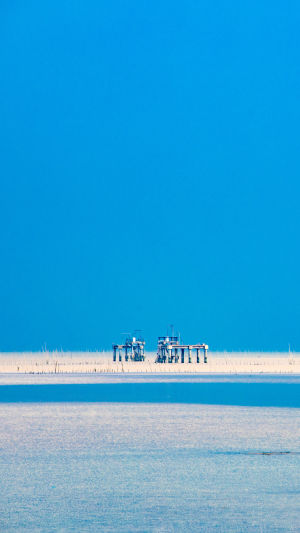Tidal flats are the general term for beaches, river beaches, and lake beaches, and refer to the tidal flooding zone between the high tide level and the low tide level of the coastal spring.
The beach area between the normal water level and the flood level of rivers and lakes, the beach area below the flood level of seasonal lakes and rivers, and the beach area between the normal water storage level and the maximum flood level of reservoirs and ponds. In geomorphology, it is called an "intertidal zone".
Due to the effect of the tide, the tidal flat is sometimes submerged by water and sometimes exposed to the water surface, its upper part is often exposed to the water surface, and its lower part is often submerged by water.
It is understood that every coastal province in China has tidal flats. The total area of tidal flats in the country is 2.08 million hectares, of which the tidal flats in the Bohai Sea and the southeast coast account for the largest proportion.
The combined tidal flats of Jiangsu, Shandong, and Zhejiang account for half, while the tidal flats in Guangdong, Guangxi, and Hainan together account for 17%.
The reason why tidal flats form such a distribution is related to China's hydrology, monsoon, and coastal flow. For example, in plain areas such as Jiangsu, Zhejiang, and Shandong, the terrain is low and flat, causing a large amount of sediment transported by rivers to deposit offshore.
Coupled with the strong effect of the southeast monsoon, the sediment is piled up on the seashore under the action of the waves, forming a vast muddy sandy coast, which is what people see as tidal flats.
Compared with the eastern coastal areas of China, Hainan's tidal flat area is not large, accounting for only 2.4% of the country's total. The tidal flat area is only larger than that of Tianjin. Although the area is small, the tidal flat has always been the home of fish, shrimps, crabs, seaweed, and shellfish in Hainan.
Tidal flats are also growing land, which is equivalent to nature helping people to reclaim land from the sea. It needs to accumulate over a long period and gradually change the topography.
Haidian Island in Haikou was originally a beach. In ancient times, the Haidian River in Haikou was the confluence of salty and fresh water, and a vast tidal flat was accumulated. There were abundant aquatic resources, and nearby villagers made a living by picking up seafood and fishing.
Relying on Haidian Creek, there were many small piers. Goods transported from the mainland had to be transported from Haidian Creek Port to Haidian Island and then transported from Haidian Island to the urban area of Haikou. With time, the area of tidal flats increased, coupled with artificial transformation, and the prototype of Haidian Island gradually emerged.
Tidal flats are also known as the "biological paradise" on the coast. In the evening, in Tanmen Bay, Qionghai City, the tide gradually receded, revealing a large open shoal. The marine life hidden under the sea water on weekdays is also exposed.
Fishermen with bamboo baskets around their waists, and tourists with buckets and shovels in their hands rush to this shallow beach to enjoy the fun of catching the sea.
Every month around the first and fifteenth day of the lunar calendar, due to hydrological effects, the tide in Tanmen Bay ebbs the farthest. Local fishermen collectively go to the tidal flats to pick up seafood according to the tidal law. This is also called "catch the sea".





